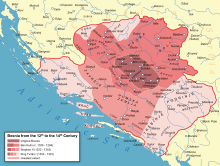Usora (zemlja)
Medieval region of Bosnia and Herzegovina From Wikipedia, the free encyclopedia
Medieval region of Bosnia and Herzegovina From Wikipedia, the free encyclopedia
Usora (Latin: Vozora, Hungarian: Ózora) was important zemlja (transl. land; feudalna oblast transl. feudal region) of the medieval Bosnian state, first banate and later kingdom, although it also had some periods outside its jurisdiction and royal authority, when it was connected with neighboring banates of Slavonia, or Mačva at times. The administrative seat of this zemlja was Srebrenik, which also served as residence for its rulers for entire period of existence of the medieval Bosnian state.[1] It took its name from the river Usora.
| Zemlja Usora Usora | |||||||||
|---|---|---|---|---|---|---|---|---|---|
| Zemlja (Land) of Bosnian Banate, Bosnian Kingdom | |||||||||
| earliest mention 20 July 1244–after 1463 | |||||||||
 Zemlja's in the development of the medieval Bosnian state. | |||||||||
| Capital | Srebrenik, Tešanj | ||||||||
| Area | |||||||||
| • Coordinates | 44.341667°N 17.269444°E | ||||||||
| Status | Zemlja (Land) | ||||||||
| Government | |||||||||
| • Type | Feudal | ||||||||
| Duke of Bosnia or Grand Knyaz of Bosnia | |||||||||
• 1241–1247 | Matej Ninoslav, | ||||||||
• 1353-1377 | Tvrtko Ivanić, | ||||||||
• 1377-1395 | Vlatko Tvrtković, | ||||||||
• 1395-1400 | Vučina Vlatković, | ||||||||
• 1400-1424 | Vukmir Zlatonosović, | ||||||||
• 1424-1430 | Vukašin Zlatonosović, | ||||||||
• 1444-1463 | Tvrtko Stančić; | ||||||||
| Historical era | Medieval Bosnia | ||||||||
• Established | earliest mention 20 July 1244 | ||||||||
• Disestablished | after 1463 | ||||||||
| Contained within | |||||||||
| • Banate | Banate of Bosnia | ||||||||
| • Kingdom | Kingdom of Bosnia | ||||||||
| Subdivisions | |||||||||
| • Type | Župa | ||||||||
| • Units | Terra Tolis, Župa Modnna, Župa Nenavište, Župa Tešanj, Župa Gradačac, Župa Visori, Župa Koraj, Župa Ukrinica; later Župa Soli, Župa Sapna, Župa Zaušije; | ||||||||
| |||||||||
| Today part of | Bosnia and Herzegovina | ||||||||
The name of the land of Usora derives from the eponymous river, which runs through its territories for approximately 80 kilometers, in direction south-southwest to north-northeast, and spills into the river Bosna just south of town of Doboj.
Usora was the northernmost Bosnian land (zemlja), occupying very fertile Pannonian Plain, and its geographical location roughly correspond to modern-day Northern Bosnia gravitating toward Posavina. Its territory stretched roughly from the area of Kulaši and Prnjavor to its west, to Srebrenik and Lukavac to its east, the river Sava to its north and Žepče to its south. The land of Usora had many strong fortresses and towns on its territory, the most famous ones being Doboj (13th century), Srebrenik (1333), Dobor fortress (1387), Glaž (12th century), Soko fortress (14th century), Tešanj (14th century), Modriča town (13th century), and Maglaj (15th century).[citation needed]
The region of Usora was first mentioned in a bull (decree) dated 20 July 1244 by the King Bela IV of Hungary, in which he assigned some properties to the Bishop of Bosnia, naming the territories: quod episeopus (Bosnensis) et capitulum decimas in Vozora, in Sou, in Olfeld et in aliis supis ... habeant et percipiant (Vozora referring to Usora, Sou to Soli, and Olfeld to Donji Kraji).[2][3]
Soli was also specially organized in the early feudal period. As such, it entered the title of Bosnian rulers, but somewhere in the first half of the 14th century it completely merged with Usora. Apart from the name and only the approximate territory, we know nothing about the organization of this zemlja.[4][5]
Although it was nominally included into the Hungarian Crown Lands, the Banate of Bosnia was a de facto independent state for the course of its existence,[6][7][8] including Usora, which under Bosnia always retained certain amount of autonomy.[9]

Notable battles include Battle of Srebrenik (1363), Battle of Dobor (1394) and (1408), and the Battle of Doboj (1415). During its history, this zemlja had been separated several times from the Banate of Bosnia and later Bosnian Kingdom, mostly by the Kingdom of Hungary which appointed rulers of this region, and sometimes attached it to Slavonian Banate. Prominent families, such as Babonići had estates there while the territories were part of Slavonian Banate. Bosnian bans and kings, starting with 1324 and Stephen II Kotromanić, who reclaimed Usora, and added both Usora and Soli to his title[10] have relinquished direct rule over Land of Usora and started appointing their vassals as rulers, ending with the last Duke of Usora, Tvrtko Stančić, who died in May 1463 during Ottoman conquest of Bosnia.
On its territory Bosnian Church flourished since the 13th century, strongly supported by local nobility. The Church held spacious land possessions, located between Dobor, in the south, and Dubnica near the Sava, in the north.
Because of its geographical location, descending from the region of low hills in its south ends and spreading through north-Bosnian lowlands into the fertile Pannonian plains towards the Sava River, Usora had rich agriculture based economy. The Sava was always frequent trading route, and had rich fisheries. This economic potential, more often than not, made Usora most common battleground between Bosnians and the Hungarian kings who viewed them as subordinate. Usora was also famous for well developed falconry among its nobility.[citation needed]

Last Usora rulers governed re-organized region after the fall of Kotromanićs and conquest of the Bosnian Kingdom's territories south of Jajce and Usora by the Ottoman Empire in 1463.
Second half of the 13th century was a period after Matej Ninoslav lost it to Hungary, and the rulers were appointed by the King of Hungary.
Seamless Wikipedia browsing. On steroids.
Every time you click a link to Wikipedia, Wiktionary or Wikiquote in your browser's search results, it will show the modern Wikiwand interface.
Wikiwand extension is a five stars, simple, with minimum permission required to keep your browsing private, safe and transparent.